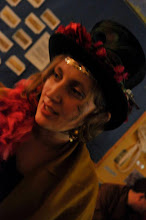This has been a glorious weekend which involved a chunk of time doing just what I fancied. Now, there's still a long list of things "to do" which didn't all get blasted through, but I did do something I hadn't been expecting - which was veritably to devour Alternative Housebuilding by Mike McClintock. A book with a story, if ever there was one...
A dear old friend (who's also a very talented artist) is the reason I have my paws on this book. He'd been doing a lot of research and reading into alternative building techniques but having done so was clearing out before a move to a new abode - and had a STACK of books about self building and sustainable building alternatives which were looking for a new home. I pretty much cleared him out of said books (it being an area of interest to me as well) on the understanding that after I'd read and digested, I'd find a suitable new home for them where lots of people could benefit from them. I had an idea of where they may next end up, but after my August WWOOFing and a conversation with the community I was staying in, that seemed like the best place for them. And, given I'm hopefully due to be dropping in on that particular community again in October, I thought I'd best get cracking on reading these books before they move into their new new home! This particular book had started (or at least, spent part of it's life) in Phoenix Public Library - which is also a rather endearing synergy with other parts of my life at the moment.
The first book I'd taken a look at was more of a "when thinking about building your own home, these are all the things you should think about" book but Mr McClintock's was exactly what this weekend needed - great photos of different types of houses, a descriptive intro on each style of building, a discussion of some of the key considerations and then some really quite detailed "and then, to get things underway..." sections (which I skimmed at best). Sustainable / alternative building techniques is something which I've been dancing around for some time - it's one of those topics which I'm interested in, but seemingly not enough to do much about. So the fortuitous engagement with these books has been rather marvellous.
The biggest thing I've learnt from the book is that, actually, the idea of designing and building my own home isn't something which is top of my priority list. Don't get me wrong, the houses which were featured looked wonderful, and the idea of a house much "closer to nature" (built of wood, or even earth walls) sounds brilliant - as long as it's someone else's plan. I'd be more than happy to get stuck in with someone else's project, but starting off on my own with one doesn't really appeal. Which was a rather surprising - but very useful! - discovery to make.
It also got me thinking about cabling and piping and all the bits of the houses I've inhabited to date which I take for granted. Which I get experts in to deal with. And which are so "normal" they're often not even really seen for the brilliant inventions that they are. Reinforcing again - I appreciate these things, but have no particular desire to become the expert myself (I've toyed with the idea of doing an electrics or plumbing course - but have always ended up discovering I'd much rather be committing my time to something else).
And of course, I also got a very informative introduction to several Alternative housebuilding approaches:
Log Houses: think log cabin. Think house made of wood. Endearing to me, but somehow didn't really hook me.
Timber-frame houses: build a frame, fill in the gaps - this one I really didn't have a lot of interest in somehow
Pole Houses: stick some poles in the ground - build your house on them. Loved this one - something about not needing to chuck down a bunch of concrete foundations for the whole footprint of the house. And that when the house was no longer being a house the footprint left on the land was so much reduced.
Cordwood masonry: why use brings when you can use logs? This one, again, sounded like a goer for me - with lots of scope for creativity with the size, shape and dimensions of the logs used. I must confess that by this point my attention span was waning, but the idea definitely sank in.
Stone masonry: too much rock. Too much heavy rock. Not inspired. At least not for me personally.
Earth masonry: ooh, now we might be talking. Although the "moulds" to make the earth masonry in looked pretty serious!
Earth-sheltered houses: possibly very cool. Possibly not. I think I'd miss the light of being above ground. But who knows.
One of the really interesting aspects of the book was that in the descriptive sections of each the author really emphasised the importance of feeling excited by the technique settled upon (either for self build or if engaging contractors to do the actual building). I think the book has furnished me with a greater awareness of construction options and will open my eyes as I see different buildings. Definitely worth a read if you're thinking of self-build at all.
Sunday, September 15, 2013
Subscribe to:
Post Comments (Atom)

No comments:
Post a Comment